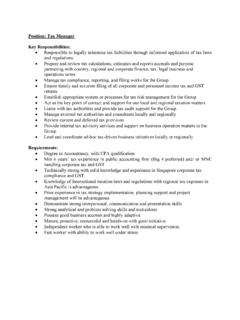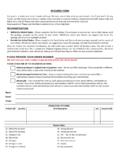Transcription of 163-2012: Comparing Stock Returns Forecasting …
1 SAS Global Forum 2012 Operations Research Paper 163- 2012 . Comparing Stock Returns Forecasting Methods Using SAS . Wei Wang, University of Arizona, Tucson, AZ. Arthur Li, City of Hope National Cancer Center, Duarte, CA. ABSTRACT. The accuracy of Forecasting Stock Returns is the key component to generating profits on Wall Street. There are many methods to Forecasting Stock Returns . Almost all the data mining methods are concerned with creating analytical models that are based on historical data trends. Choosing the best Forecasting method is essential to obtaining fruitful Stock Returns . SAS provides a flexible platform that allows one to easily compare different Forecasting methods. In this paper, we compare three most- commonly-used technical trading methods (Moving Average, Relative Strength Index, and Bollinger Bands) by using SAS based on historical stocks from 1980 to 2010. All the calculations are performed by utilizing the DATA step or SAS macros.
2 The comparison generated from the program helps us to decide the best Forecasting method. INTRODUCTION. Common ways to perform Stock analysis in the real world are fundamental analysis and technical trading analysis. This paper focuses on testing the efficiency of technical trading methods. Between the 1890s and the 1980s, scholars have proven that these methods are quite efficient, but not so much for the data after the 1980s. In this paper, we chose three of the most popular technical trading methods, Moving Average, Relative Strength Index, and Bollinger Bands, to compare their efficiencies based on data between Jan. 2, 1981 to Dec. 31, 2010 from the NYSE. DATA SAMPLE. In order to maintain integrity and consistency, we will keep only those stocks that were actively traded during the entire 30 year period. Thus, 355 individual stocks made the grade. There is one more reason that we only tracked these 355 stocks : the size of our daily data sample is above 4G.
3 Without the filter, the size of more than 1000 NYSE daily Stock data would be too large for us to calculate on our computer. When we choose a buy-and-hold strategy for these stocks , the average daily return of these 355. stocks is the benchmark of our technical analysis. Here are the first 5 observations of our data set. In this dataset, the DATA is the trading date, CUSIP is the Stock ID, RET is the daily return of Stock , and ADJPRC is the adjusted price for Stock . Obs DATE CUSIP RET adjprc 1 19810102 00036110 2 19810105 00036110 3 19810106 00036110 4 19810107 00036110 5 19810108 00036110 The average daily return of these 355 stocks is (with SD = ). If the predicted return from any of the technical methods is greater than this threshold, it means that this method is proven to be efficient. MOVING AVERAGE METHOD. Moving Average is one of the most popular and classical technical analysis methods. The basic idea of the moving average strategy is that a moving average line has a resistance or support effect.
4 Also the investors can use this strategy very easily. For example, the 10-day moving average number for day n is the average closing price from day n-9 to day n. Usually, the 1-day, 2-day and 5-day moving average lines appear to be short period ones; the 50-day, 150-day and 200-day moving average lines appear to be long period ones. The essence of this strategy is that when the short moving average line cuts the long moving average line from below, it is a buy signal; otherwise, it's a sell signal. We assume the investor will hold or sell the Stock until the next buy or sell signal exists; we call this 1. SAS Global Forum 2012 Operations Research strategy a Variable-Length Moving Average (VMA). If an investor will hold or sell a Stock after a fixed period, we call it a Fixed-Length Moving Average (FMA). We define moving average by using the following program: Program 1A: data MA;. set ;. MA2 = adjprc;. MA5 = adjprc;. MA50 = adjprc;. MA150 = adjprc.
5 MA200 = adjprc;. run;. proc sort data = MA;. by cusip date;. run;. %macro calave(days);. %do i = 1 %to . data MA;. set MA;. MA&days = MA&days + lag&i(adjprc);. if &i = &days-1 then MA&days = MA&days/ . if &i = &days-1 then do;. if &days = 2 and date<mdy(01,05,81) then MA2 = .;. if &days = 5 and date<mdy(01,08,81) then MA5 = .;. if &days = 50 and date<mdy(03,13,81) then MA50 = .;. if &days = 150 and date<mdy(08,05,81) then MA150 = .;. if &days = 200 and date<mdy(10,15,81) then MA200 = .;. end;. run;. %end;. %mend;. %calave(2). %calave(5). %calave(50). %calave(150). %calave(200). data ;. set MA;. run;. The next step is to use the following code to test our VMA moving average data set. Here is an example where we test the 1-day/200-day, 1-day/150-day, and 1-day/50-day strategy. Program 1B: data MAresult;. set ;. run;. proc means data = MAresult noprint;. var ret;. output out = buyandhold n = BHn mean = BHmean std = BHstd;. run;. data MAresult.
6 Set MAresult;. if adjprc=. or MA200=. then status = 0;. 2. SAS Global Forum 2012 Operations Research else if adjprc>MA200* then status = 1; *VMA buy(1,200, );. else if adjprc<MA200* then status = -1; *VMA sell(1,200, );. else status = 0;. if adjprc=. or MA50=. then status = 0;. else if adjprc>MA50* then status = 1; *VMA buy(1,50, );. else if adjprc<MA50* then status = -1; *VMA sell(1,50, );. else status = 0;. if adjprc=. or MA150=. then status = 0;. else if adjprc>MA150* then status = 1; *VMA buy(1,150, );. else if adjprc<MA150* then status = -1; *VMA sell(1,150, );. else status = 0;. run;. proc sort data = MAresult;. by status;. run;. proc means data = MAresult noprint;. var ret;. by status;. output out = buyandsell n = BSn mean = BSmean std = BSstd;. run;. data VMAfinal; *VMA final result!;. merge buyandhold buyandsell;. by _TYPE_;. drop _FREQ_ _TYPE_;. if status ~= 0 then t =(BSmean-BHmean)/sqrt(BHstd*BHstd/BHn+BH std*BHstd/BSn);. run.
7 SAS Output (1-day/200-day): BHn BHmean1 BHstd status2 BSn3 BSmean4 BSstd t 2684107 -1 941759 2684107 0 242051 . 2684107 1 1500297 1. The daily return of benchmark 2. -1 means sell signal, 1 means buy signal 3. Bsn is the number of how many buy or sell signals in this period 4. BSmean is the average return for buy or sell signal SAS Output (1-day/150-day): BHn BHme an BHstd status BSn BSme an BSstd t 2684107 -1 963737 2684107 0 255045 2684107 1 1465325 SAS Output (1-day/50-day): BHn BHme an BHstd status BSn BSme an BSstd t 2684107 -1 989249 2684107 0 379454 . 2684107 1 1315404 In the above output, we can see a 1-day and 200-day moving average strategy can earn at buy side and at sell side, which is much higher than our benchmark of , which has almost the same result as the 1-day and 150-day moving average strategy and the 1-day and 50-day moving average strategy. Clearly, on average, investors can obtain higher profits when they choose a variable-length moving average strategy, whether they long sell a Stock in a buy period or short sell 3.
8 SAS Global Forum 2012 Operations Research one in a sell period. We have essentially the same result for the Fixed-Length Moving Average (FMA). RELATIVE STRENGTH INDEX (RSI) STRATEGY. RSI is another popular technical analytical strategy. The basic idea of the RSI strategy is very different from the moving average strategy. RSI strategy focuses on the total gain or loss in prior market days. From the total gain or loss information, investors will know whether the overbought or oversold phenomenon has existed. The detailed formula of calculating RSI is as follows: RS = Ave. Gain / Ave. Loss in prior n days;. RSI = 100 100 / (1+RS). From the formula above, we know that RSI is a number between 0 and 100. Usually, if RSI>80, the investor overbought for several days and they should sell the Stock ; if RSI<20, it the investor oversold and they should buy the Stock . In our paper, we use a 14-day RSI, which means we calculate the average gain or loss in the previous 14 days of trading.
9 This is how we define RSI in SAS: Program 2A: data RSI;. set RSI;. by cusip;. ladjprc = lag(adjprc);. if adjprc>ladjprc then gain = adjprc-ladjprc;. if adjprc<ladjprc then loss = ladjprc-adjprc;. if then do;. gain = .;. loss = .;. end;. retain days 0;. days+1;. if then days = 1;. if gain = . then gain = 0;. if loss = . then loss = 0;. retain sumgain 0;. sumgain = sumgain + gain;. retain sumloss 0;. sumloss = sumloss + loss;. if days=15 then do;. AveGain = (sumgain-gain) / 14;. AveLoss = (sumloss-loss) / 14;. RS = AveGain / AveLoss;. RSI = 100-100/(1+RS);. end;. drop sumgain sumloss;. run;. %macro calRSI();. %do i=16 %to 7570;. data RSI;. set RSI;. lAveGain = lag1(AveGain);. lAveLoss = lag1(AveLoss);. if days = &i then do;. AveGain = (lAveGain*13+gain)/14;. 4. SAS Global Forum 2012 Operations Research AveLoss = (lAveLoss*13+loss)/14;. RS = AveGain / AveLoss;. RSI = 100-100/(1+RS);. end;. %end;. %mend;. %calRSI;. data ;. set RSI;. run;. The following program is a sample for the Variable-Length RSI (VRSI).
10 We define Variable-Length RSI. strategy based upon an overbought signal (RSI>80); the investor short sells the Stock until RSI<60;. when an oversold signal (RSI<20) appears, the investor long sells the Stock until RSI>40. Program 2B: data VRSIB;. set RSIresult;. by cusip;. drop status;. retain period 0;. if then period = 0;. if RSI<20 then period = 1; *RSI<20 buy and until RIS>40;. if RSI>40 then period = 0;. RealPeriod = lag(period);. if RealPeriod = 0 then delete;. run;. data VRSIS;. set RSIresult;. by cusip;. drop status;. retain period 0;. if then period = 0;. if RSI>80 then period = 1; *RSI>80 sell and until RIS<60;. if RSI<60 then period = 0;. RealPeriod = lag(period);. if RealPeriod = 0 then delete;. run;. proc means data = VRSIB;. var ret;. run;. proc means data = VRSIS;. var ret;. run;. SAS Output: The MEANS Procedure Analysis Variable : RET Returns N Mean Std Dev Minimum Maximum 41247 In the above output, we can see that the average daily return is , which is much higher than the benchmark.

















